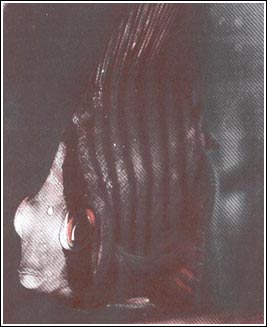

 |
||||||||||||
 |
||||||||||||
| Emaciated Discus and Capillaria Worms | ||||||
| Ardan Huck | May 24, 2002 | |||||
The pictures below were used with permission from "Handbook of Fish Diseases" by TFH Publications, Inc.  Photo 1: When a fish exhibits signs of emaciation, (i.e. caved in sides, eyes sunken in) it is possibly being starved by intestinal flagellates (a protozoa such as Spironucleus or Hexamita) or intestinal worms (tapeworm, nematode, capillaria, oxyuridia). Generally the worms or flagellates are carried by fish, expelled in the feces and picked up by other fish by eating infested feces. The feces may contain worms or eggs. Positive identification is made through the use of a microscope on the feces.
Photo 1: When a fish exhibits signs of emaciation, (i.e. caved in sides, eyes sunken in) it is possibly being starved by intestinal flagellates (a protozoa such as Spironucleus or Hexamita) or intestinal worms (tapeworm, nematode, capillaria, oxyuridia). Generally the worms or flagellates are carried by fish, expelled in the feces and picked up by other fish by eating infested feces. The feces may contain worms or eggs. Positive identification is made through the use of a microscope on the feces.
If the fish has slimey white or gray feces it is more likely to be a flagellate infestation and can be treated with metronidazole in the feed and/or in the water. Increasing the temperature to 90 to 94 degrees F. makes the drug more effective. At lower temperatures, higher doses are used. Doses at 400mg/10 gallons every 8 hours for 2 days can be used. Generally first treat for flagellates, then if necessary, for internal worms. http://thatwebplace.hypermart.net/aquatic/seascope/worm.html Slimy white feces may also be caused by an internal worm called Capillaria. For internal worms, Prazi may be used for tapeworms. Flubenzadol may be use for nematodes (Capillaria, Oxyuridia). According to Dieter Untergasser (1989) it will kill the worms and their eggs. Treatment must run at least 15 days. Garlic in the food has been shown to eliminate internal worms. Pipzine (piperazine citrate) mixed in the food at 1 capsule/1.5 oz food according to Dieter Untergasser. Capillaria may be treated with Di-n-butyl tin oxide according to Jack Wattley’s Handbook of Discus (Di-n-butyl stannate is found in "Disco Worm"). Capillaria may also be treated with Dylox (Dyacide) according to Jack Wattley’s "Handbook of Discus" (1985). Capillaria may be treated with Panacur. Good clean water conditions are essential for health, as is a clean aquarium. Increase in temps results in an increased metabolism which may stimulate eating, however if the fish is in a weakened state already, the increased metabolism may wear the fish out. If the fish is already weakened, its resistance to other diseases/parasites is greatly diminished. more ... |
 |
|||||
| About Us :: Message Board :: Chat | |||||
| Library :: Photo Gallery :: Links & Resources :: Breeders & Sponsors :: Merchandise | |||||
| Website designed by: EthanCote.com | © 2001-2004, SimplyDiscus.com. All Rights Reserved. | ||||